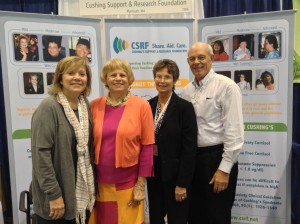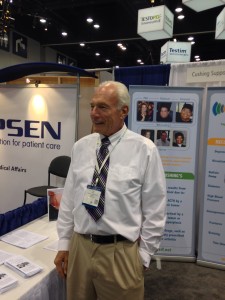Once again, the CSRF exhibited at the annual meeting of The Endocrine Society. This year’s meeting held June 21-24, 2014 in Chicago, IL, was a combined meeting with the International Congress of Endocrinology. During the course of the 3 day exhibit, we had the opportunity to discuss Cushing’s with national and international endocrinologists, endocrine nurses and other attendees. We had an excellent booth location this year, which increased traffic over other years, but we’d welcome the chance to talk with even more attendees. This year’s exhibit was staffed by Louise Pace, and Karen and Dave Campbell. Two CSRF members in the Chicago area, also helped with the booth; Barb Gallagher (Elmhurst, IL) and Greg Royer (Lake Bluff, IL).
After almost 20 years of exhibiting at these annual meetings, it seems that the topic of Cushing’s is finally getting the attention it deserves! Previously, many Cushing’s sessions were held on the last day after many attendees had already departed and sessions were poorly attended. This year, there were a number of symposia, oral presentations, posters and Meet the Professor sessions that were held early in the meeting. Most ALL of the presentations on Cushing’s were filled to capacity with standing room only and in some cases, attendees were moved to overflow rooms. A Continuing Medical Education symposia titled “Clinical Decisions in Cushing’s Disease” started at 6:00 on Sunday morning and was filled to capacity. This means that well over 450 people were in attendance bright and early in the morning! This program was chaired by Dr. Beverly MK Biller (Mass. General Hospital) and included talks on surgical and radiologic outcomes (Dr. Michael Buchfelder, Univ. of Erlangen-Nuremberg), diagnosis of Cushing’s (Dr. Jay Findling, Medical College of Wisconsin) and the role of medications in Cushing’s (Dr. Peter Trainer, Univ. of Manchester). As usual, the number of excellent technical presentations are too numerous to completely summarize, but what follows is a brief summary of some highlights. Perhaps one of the more novel items presented at this year’s meeting was an oral presentation on the measurement of salivary cortisol using a smart phone app. In this presentation Ehrenkranz, et al, (Intermountain Healthcare) described preliminary information on an attachment for a smart phone that can measure salivary cortisol in 5 minutes using 70ul of saliva for minimal cost. It is envisioned that this device may be useful to measure cortisol at the point of service in doctor’s offices, in countries without good laboratory access and for patients who want to monitor their cortisol. While this is an exciting development, no normal values have been established and more studies are needed.
In an oral session titled, “Diagnosing and Treating Cortisol Excess and Deficiency” Carroll (Medical College of Wisconsin) et al, discussed a study of 10 patients with recurrent Cushing’s Disease. All of these patients had normal 24hr urines, 8 out of 10 had abnormal dexamethasone suppression tests and ALL 10 patients had elevated late night salivary cortisol, indicating that the late night salivary cortisol test may be the most sensitive test for detection of recurrent Cushing’s. Metyrapone medical therapy is not often used in the US, but it is used in Europe. In a study by Daniel (Univ. of Sheffield), et al, of 138 patients over an average of 162 days, metyrapone decreased cortisol levels to normal in 70% with side effects observed in about 25% of patients, usually at the start of treatment or at a dose change. The last paper in this session discussed the use of medications to control Cushing’s prior to surgery. Valassi (Univ. of Barcelona), et al, used the ERCUSYN database of Cushing’s patients and found that 25% (228 out of 930 patients) received medication prior to surgery. The most common medication used was ketoconazole and medications were used more in the Netherlands than other countries. This study also found that 70% of those not treated with medications prior to surgery developed adrenal insufficiency following surgery, while only 30% of those treated with medications prior to surgery developed adrenal insufficiency following surgery. This indicates that perhaps the HPA axis recovers while on medications which might complicate the use of adrenal insufficiency as a measure of surgical cure for patients that have been treated with medications.
In a session titled “Management of Persistent/Recurring Pituitary Tumors”, Dr. Biller discussed the frequency of this situation for Cushing’s. Summarizing 28 different studies, 3-49% had persistent Cushing’s following surgery and 2-27% had recurrences. Dr. Biller stressed the need for long term follow up as well as treatment options including radiation and medications. In another oral session, Pivonello (Univ. Federico, Naples), et al, reported on the medication LCI 699, a steroid synthesis inhibitor, in 19 patients. Cortisol was controlled in 78.9% of patients, was well tolerated and 16/19 patients opted to extend their time on the medication to 12 mo. A Phase 3 trial is planned to start in 2014.
In a symposium on Adrenal Cushing’s, Bertherat (Institut Cochin, Paris) discussed the genetic basis of macronodular bilateral adrenal hyperplasia and Fassnacht (Univ. of Wuerzburg) discussed the genetic basis of adrenal adenomas. (Both of these subjects were addressed in the Spring 2014 issue of the CSRF newsletter). Terzolo (Univ. of Turin) addressed the subject of adrenal incidentalomas and subclinical Cushing’s. Adrenal incidentalomas are tumors discovered by accident on abdominal CT scans. Dr. Terzolo pointed out that adrenal incidentalomas are found in 3-5% of abdominal CT scans and that in 2012, approximately 1 million abdominal CTs were done in Italy thus, this is not a rare occurrence. Sub-clinical Cushing’s (SCC), can be defined as a patient that has no specific symptoms of Cushing’s, but may have signs of Cushing’s that include obesity, type 2 diabetes, osteoporosis, etc. When patients with adrenal incidentalomas are evaluated for Cushing’s, studies have shown SCC to be present in 5-45%, depending on the criteria used, thus diagnostic criteria need to be addressed. Debono (Univ. of Sheffield, UK) discussed whether these patients should be surgically treated. Reports on the value of surgery have been inconsistent. He pointed out that obesity, type 2 diabetes and hypertension are common in the population and diagnostic criteria are needed to identify those patients who would benefit from surgery as cardiovascular issues and mortality could be decreased.In a Meet the Professors session titled, “New Treatment for Cushing’s”, Dr. Stylianos Tsagarakis (Athens, Greece) discussed current medications for Cushing’s as well as some of those on the horizon, including COR-003 (see clinical trials), LCI699 (see clinical trials) and retinoic acid which is under study in Europe. Retinoic acid has been shown to be effective in about 70% of patients. While improvements in medications for Cushing’s are coming along, Dr. Tsagarakis concluded that treatment of Cushing’s with medications is not yet at the stage where medications are a first line treatment as is the case with agromegly and prolactimomas. Other Meet the Professor sessions on Cushing’s included Bilateral Macronodular Adrenal Hyperplasia by Lacroix (Univ of Montreal), Cushing’s Syndrome: New Approaches by Nieman (NIH), Childhood Cushing’s by Shah (Mumbai) and Adrenal Nodules by Terzolo.
In the posters, a Russian study by Rozhinskaya (National Endocrinology Research Center), et al used the Russian National Registry of patients with pituitary tumors and estimated the prevalence to be more than 3 per 1 million of population. This study also found significant disability among those with Cushing’s. Leal-Cerro (Inst. Biomedicina de Sevilla) reported on a multicenter study of high risk populations in Spain. This study selected patients with at least 2 of the following conditions: obesity, uncontrolled hypertension in spite of medications, or poorly controlled diabetes and screened them for Cushing’s using a late night salivary cortisol test. Preliminary results of 202 patients indicated that Cushing’s could be ruled out in about 70% of these patients and was confirmed in about 11%, with the rest needing further evaluation. Broder (Parternership for Health Analytic Research), et al used a large health care insurance data base to identify Cushing’s disease patients and compared them with controls. Findings were that Cushing’s disease patients had much higher rates of abnormal weight gain, osteoporosis and polycystic ovarian syndrome. Studies are continuing to determine if a set of conditions might be useful in identifying a possible Cushing’s diagnosis earlier.
While the measurement of cortisol in hair is not available in the US except as part of on-going studies at NIH, it was discussed in 3 different posters. Zilbermint (NIH) et al discussed the preliminary use of the hair cortisol in 5 Cushing’s patients, Staufenbiel (Erasmus Medical Center), et al reported that patients on replacement cortisol show higher levels of cortisol than the normal population, perhaps indicating that some patients are being over replaced, and Wester (Erasmus Medical Center), et al found that obese patients had higher hair cortisol than overweight and normal weight patients which could potentially contribute to cardiovascular issues in these patients.
Kreitschmann-Andermahr (Univ. of Essen-Duisburg), et al presented results of a patient survey on the quality of life and psychosocial well-being of Cushing’s patients post successful treatment. In responses by 101 patients, 28.7 % suffered from severely reduced psychological quality of life, 11.9% from depression and 22.8% from anxiety. This study found that negative coping styles can play a role in quality of life and suggested that counselling sessions on positive coping styles could be useful to Cushing’s patients.
The safety of ketoconazole was the subject of a study by Sharma (NIH), et al. 150 patients on ketoconazole were studied for liver problems associated with ketoconazole. Severe liver difficulties were observed in 17% of patients but none were associated with liver failure. Patients under 30 years of age and on higher doses were more likely to have liver problems and the odds of having liver problems decreased with longer duration of use.
Chapman (Univ. of Birmingham), et al investigated suppression of normal cortisol secretion in a large group of patients who were prescribed glucocorticoids for various conditions and found that inadequate cortisol production occurred in a significant number of patients. This is not a small problem as up to 2-3% of the US and UK populations are prescribed glucocorticoids.
In the area of long term research, Hochberg (Rambam Health Care Campus), et al looked at gene expression patterns in fat tissues obtained from patients with Cushing’s and those undergoing pituitary surgery for another type of pituitary tumor. A number of genes involved in glucose metabolism and cholesterol synthesis were shown to be higher in Cushing’s patients, thus may be responsible for the effects of glucocorticoids on fat tissue. Halem (Ipsen), et al, discussed the use of ACTH receptor blocking peptides in laboratory studies in rats. While a number of years away, these compounds may eventually be useful for treatment of Cushing’s patients.
You may read the abstracts yourself on The Endocrine Society website: select meetings, then Endo 2014, scientific program.
Editor’s note: This article was written by Karen Campbell, Director, CSRF and reviewed by Dr. James Findling, Endocrinologist, Medical College of Wisconsin.








Sorry, comments are closed for this post.